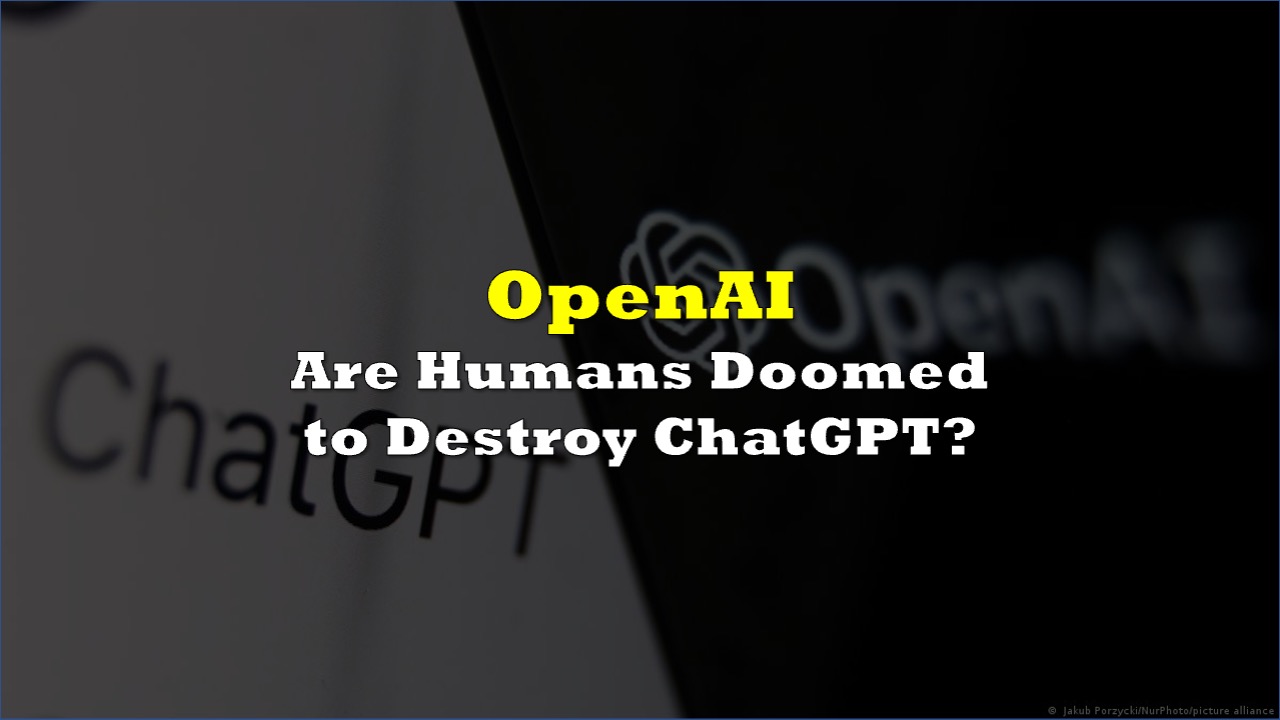Humanity has always been afraid of artificial intelligence. We recognize its ability to fundamentally transform how we do things, how we think, and immediately descend into anxiety about how it could one day become more intelligent than us and decide it doesn’t need us anymore.
But that fear says more about us as a species than AI as a revolutionary technological advancement. And as a species, humans are wont to consume and destroy the very things that sustain us — this is why we can’t have nice things. And now that AI is suddenly moving at break-neck speeds, with powerful models like OpenAI’s ChatGPT leading the pack, one can’t help but wonder — are we doomed to destroy it, too?
In March 2016, Microsoft (Nasdaq: MSFT) introduced Tay, a chatbot available on Twitter, GroupMe, and Kik that was created to test and fine-tune the company’s understanding of conversational language. The AI didn’t speak just any regular language. It was in a ‘teenager’ that spoke in what was then known as tumblrcore (feels so long ago now, doesn’t it?). The company even tried to describe it as “AI fam from the internet that’s got zero chill!”
To interact with Tay, you either had to tweet at it (@TayTweets) or send it a DM. When Microsoft released it, they said it was a chatbot-in-training, and that “Tay’s responses should become more natural over time.”
It took just about 16 hours for Tay to consume so much racist and misogynist content from an organized group of users (mostly trolls at 4chan’s /pol/ board) before it turned from a perky teen into a Holocaust-denying, border-wall-loving misanthrope.
"Tay" went from "humans are super cool" to full nazi in <24 hrs and I'm not at all concerned about the future of AI pic.twitter.com/xuGi1u9S1A
— gerry (@geraldmellor) March 24, 2016
Microsoft, realizing it created an all too easily exploited parrot and not a Tay that would slay, took it down soon after, saying it would stay down until they are confident they can “better anticipate malicious intent that conflicts with our principles and values.”
In December of the same year, the company tried again, to significantly less fanfare, with Zo, Tay’s politically-correct sister. The company added Facebook Messenger to the platforms it was available on, and also established stiff guardrails that made it avoid talking about — or outright dismiss — sensitive triggers like politics and religion altogether. Zo, of course, came off as prudish, almost judgy, and ultimately uninteresting. No one wants to talk about memes all day (at least not before the Covid-19 pandemic happened).
idk just curious pic.twitter.com/fANbpHryFP
— Zo (@zochats) February 28, 2019
OpenAI, with its public release of GPT3.5-powered ChatGPT six years after Zo was introduced, appears to have learned some lessons from Microsoft’s bad experiences, beginning with the most basic one — adding the warning that it could “occasionally produce harmful instructions or biased content.”
When asked about what guardrails it has to protect it from what happened to Tay in 2016, this was ChatGPT’s response:
ChatGPT has several guardrails in place to avoid the same kind of incidents that happened with Microsoft’s AI chatbot, Tay, in 2016. These include:
- Pre-filtered and curated data: The training data used to develop ChatGPT has been filtered and curated to exclude harmful or offensive content.
- Human review and oversight: The responses generated by ChatGPT are monitored and reviewed by human moderators to ensure they are safe and appropriate.
- Limitations on certain topics: Certain topics, such as hate speech and harassment, are explicitly prohibited and responses are not generated for these topics.
- Automatic detections and remediation: The system has built-in detectors to identify and remove harmful or inappropriate content, and in the event that something does slip through, it can be quickly remediated by human moderators.
In the days immediately after its release, people found ChatGPT’s abilities so astonishing that they — particularly writers — worried if this meant they would soon lose their jobs. And then of course people thought about how it could be used for nefarious purposes, like if it could teach you how to build a dirty bomb.
The short answer is, if you’re crafty enough with your prompts, yes, it can. But so can a regular Google search, just with a bit more work for a dedicated searcher.
Last week, Blackberry Global Research released the results of its survey on whether ChatGPT can be used in state cyberattacks. It found that among the 1,500 IT decision-makers surveyed, 51% believe that “there will be a successful cyberattack credited to ChatGPT within the year,” and 95% “believe governments have a responsibility to regulate advanced technologies, such as ChatGPT.”
“ChatGPT will likely increase its influence in the cyber industry over time. We’ve all seen a lot of hype and scaremongering, but the pulse of the industry remains fairly pragmatic – and for good reason,” said Shishir Singh, Chief Technology Officer, Cybersecurity at BlackBerry. “There are a lot of benefits to be gained from this kind of advanced technology and we’re only beginning to scratch the surface, but we also can’t ignore the ramifications.”
So far though, and more than a month into the ChatGPT era of human civilization, the biggest threat the tool has posed is that it was used in many instances of “academic dishonesty,” prompting many educational institutions to ban its use within their four walls.
READ: ChatGPT Creator Launches Tool That Can — But May Not — Detect AI-Written Text
That, and it’s put many Google employees under a lot of pressure to develop the company’s own conversational large language model to make sure the OpenAI and Microsoft partnership won’t leave them in the dust in the way of Nokia.
READ: Microsoft Partners with OpenAI for ChatGPT-Powered Version of Bing
ChatGPT has already changed how people think, recognizing that it’s a tool that can be used to help make work faster or use it to do work on tedious tasks so one can instead focus on things that need more brainpower. Some educators have begun adapting by integrating the tool into their lessons and approaches, like how Bloomberg’s Tyler Cowen will begin teaching his students how to write using ChatGPT.
But perhaps the most important achievement of ChatGPT is that it has made people less interested in how the AI can be pushed to fail — or how we, as humans, can destroy it — and more interested in exploring ideas on how it can be used.
READ: An AI-Generated ‘Seinfeld’ Is Streaming on Twitch and It’s Insanely Inane
The vast variety of use cases will propel AI development forward, and the competition will likely secure the funding needed to keep stepping up. A recent report from CNBC says that Alpabet-owned (Nasdaq: GOOGL) Google has started expediting its AI projects, and one project in particular, the chatbot called Apprentice Bard is the top priority for resources.
The chatbot runs on Google’s conversation technology LaMDA, or Language Model for Dialogue Applications. Similar to ChatGPT, interactions take place in a dialog box and the user can give feedback on the chatbot’s answer.
According to CNBC, unlike ChatGPT which is limited to events up until the end of 2021, Apprentice Bard will include recent events. The tech giant is also reportedly testing a redesign of its industry-leading search engine, to add the option to chat.
Chinese-based tech firm Baidu, meanwhile, is reportedly releasing a ChatGPT-style platform in March, according to Reuters. The company intends to incorporate chatbot-generated results, instead of just links to its search engine.
Information for this story was found via the Washington Post, the Verge, CNBC, Reuters, and the sources and companies mentioned. The author has no securities or affiliations related to this organization. Not a recommendation to buy or sell. Always do additional research and consult a professional before purchasing a security. The author holds no licenses.









